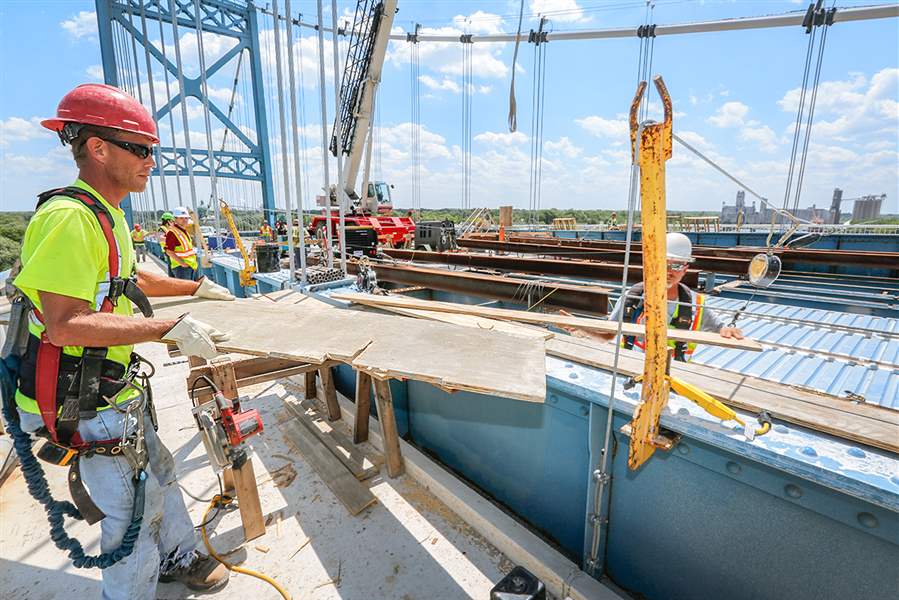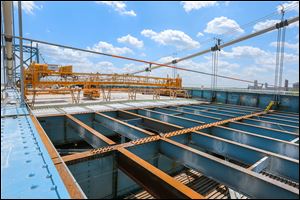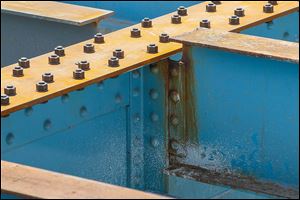
Anthony Wayne Bridge gets 2nd overhaul in 83 years
Beams exposed, all lanes closed in $28.7M makeover to be finished in ’15
6/4/2014
Eric Johnston of Norwalk passes a board to Marty Goon of Genoa, partially obscured, at work on the Anthony Wayne Bridge, which connects East Toledo to the rest of the city. Often called the High Level Bridge, it was built in 1931.
THE BLADE/JETTA FRASER
Buy This Image

Eric Johnston of Norwalk passes a board to Marty Goon of Genoa, partially obscured, at work on the Anthony Wayne Bridge, which connects East Toledo to the rest of the city. Often called the High Level Bridge, it was built in 1931.
Beneath the Anthony Wayne Bridge’s concrete deck is a lattice of steel beams that for 83 years have ultimately shouldered the daily load of thousands of cars and trucks.
Now, as part of the bridge’s second major overhaul since its construction, those beams are being exposed to the sky with removal of the main suspension span’s deck. They are being repaired or replaced as needed before a new concrete deck is built atop them.
PHOTO GALLERY: Click here to view
Crews from Oregon-based contractor E.S. Wagner will replace heavy steel cover plates from every other one of the bridge’s crosswise beams, while lengthwise stringer beams and steel angles are replaced as needed.

Three state routes — 2, 51, and 65 — cross the Maumee River via the Anthony Wayne Bridge, which connects Clayton Street near downtown to Woodville Road in East Toledo. The bridge is to reopen in September, 2015. Its 1930s-vintage decorative railings are to be restored and returned.
The cover-plate replacements are part of why the Ohio Department of Transportation project has required closing the bridge to all traffic instead of rebuilding it one half at a time and keeping two lanes open, said David Geckle, ODOT’s project engineer.
The plates are just shy of 40 feet long, spanning nearly the entire width of the roadway, and can’t be replaced one half at a time, he explained Tuesday during media worksite tours.
This phase of the bridge’s $28.7 million makeover is further broken down into stages in which roughly square portions of the deck are opened up. As of Tuesday, work was well into the third of 10 stages, with the middle-most portion of the new deck completed and two open sections on either side, each with its own construction crew.
So far each stage has taken about three weeks to complete.
“Once we get closer to the towers, it will be a little more work — it’ll take about four or five weeks” to complete each section, Mr. Geckle said.
“It looks like it’s progressing well,” said Todd Audet, ODOT’s district deputy director in Bowling Green, who was making his first comprehensive tour of the construction site Tuesday since the bridge closed to traffic in mid-March.
“There’s a lot of work to be done, but at this point, we’re still pretty much on schedule,” Mr. Geckle said.
The structure, also known as the High Level Bridge, is to reopen in September, 2015.
Once the steel work is done, the main span is being rebuilt with special lightweight concrete that requires bringing in stone from northeast Ohio instead of using locally sourced limestone in the mix.
The lighter weight reduces the “dead load” on the bridge’s steel, which should lengthen the current overhaul’s useful life, Mr. Geckle said.
Mr. Audet said he was impressed to learn that the new concrete’s lighter weight will result in the bridge being four inches higher above the Maumee River than it was before the project began.

Bolts are used for the new work on the span, whereas rivets had been used originally. The refurbished bridge is to be lighter than the original, which is predicted to extend the life of the span.
Once the main span is finished late this year, Wagner’s crews will tear down completely the first approach spans on either end and replace them.
Those spans are another key reason for the project’s complete traffic shutdown — they simply aren’t designed to be removed one half at a time.
Other work now under way includes replacing the sidewalks on the bridge’s other approach spans. The 1930s-vintage decorative railings are being carefully dismantled and stored so they can be refurbished off-site and then returned for reinstallation.
Sidewalks on the main span, Mr. Geckle said, won’t be replaced because they were rebuilt during the mid-1990s, when the deck surface also was ground off and overlaid with concrete. A previous deck replacement occurred during the mid-1960s.
Contact David Patch at: dpatch@theblade.com or 419-724-6094.